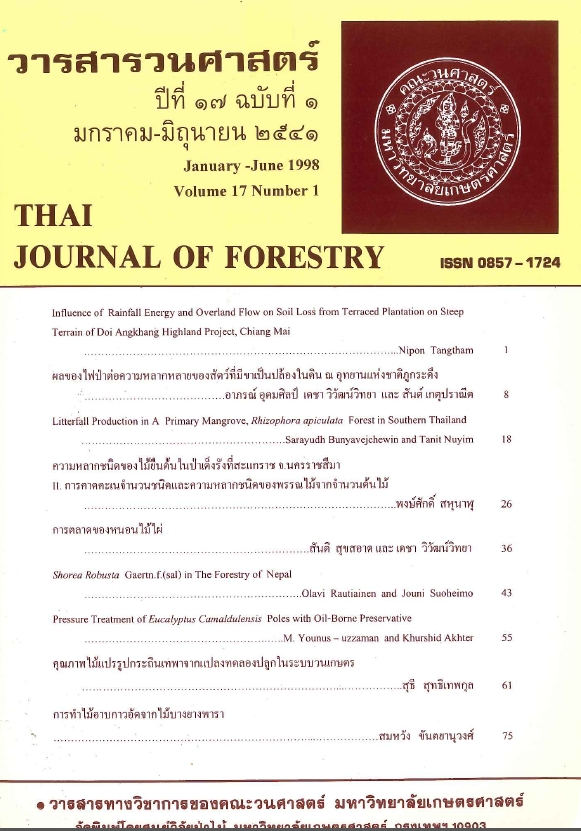SHORES ROBUSTA GAERTN.F. (SAL) IN THE FORESTRY OF NEPAL
Main Article Content
บทคัดย่อ
The distribution, silvicultural characteristics, growth rate and economic importance of S robusta Gaertn.f., an indigenous hardwood species in Nepal, were analysed. The natural S robusta forests in the southern plains of Nepal (the Bhabar-Terai) have been seriously degraded during the past decades. Forest inventories and trials in Nepal have revealed a good regeneration potential for the existing S robusta forests. After regeneration felling the new S. robusta crop reaches a standing stem volume of 100 m3 ha-1 in ten years. With an average site quality of 1/11, the maximum mean annual increment of stemwood (15 m3 year-1) is reached after 25 years and the maximum sawlog size wood MAL (5.7 m3 year-1. 20 cm top, under bark) after 60 - 70 years. The productivity of the dense naturally regenerated young forests is on a par with the commonly planted species in Nepal.
Keywords: Shorea robusta Gaertn.f., sal, Nepal, silviculture, growth, forest management
Downloads
Article Details

อนุญาตภายใต้เงื่อนไข Creative Commons Attribution-NonCommercial-NoDerivatives 4.0 International License.
ข้าพเจ้าและผู้เขียนร่วม (ถ้ามี) ขอรับรองว่า ต้นฉบับที่เสนอมานี้ยังไม่เคยได้รับการตีพิมพ์และไม่ได้อยู่ในระหว่างกระบวนการพิจารณาตีพิมพ์ลงในวารสารหรือสิ่งตีพิมพ์อื่นใด ข้าพเจ้าและผู้เขียนร่วม (ถ้ามี) ยอมรับหลักเกณฑ์และเงื่อนไขการพิจารณาต้นฉบับ ทั้งยินยอมให้กองบรรณาธิการมีสิทธิ์พิจารณาและตรวจแก้ต้นฉบับได้ตามที่เห็นสมควร พร้อมนี้ขอมอบลิขสิทธิ์ผลงานที่ได้รับการตีพิมพ์ให้แก่วารสารวนศาสตร์ คณะวนศาสตร์ มหาวิทยาลัยเกษตรศาสตร์ กรณีมีการฟ้องร้องเรื่องการละเมิดลิขสิทธิ์เกี่ยวกับภาพ กราฟ ข้อความส่วนใดส่วนหนึ่ง หรือ ข้อคิดเห็นที่ปรากฏในผลงาน ให้เป็นความรับผิดชอบของข้าพเจ้าและผู้เขียนร่วม (ถ้ามี) แต่เพียงฝ่ายเดียว และหากข้าพเจ้าและผู้เขียนร่วม (ถ้ามี) ประสงค์ถอนบทความในระหว่างกระบวนการพิจารณาของทางวารสาร ข้าพเจ้าและผู้เขียนร่วม (ถ้ามี) ยินดีรับผิดชอบค่าใช้จ่ายทั้งหมดที่เกิดขึ้นในกระบวนการพิจารณาบทความนั้น”


